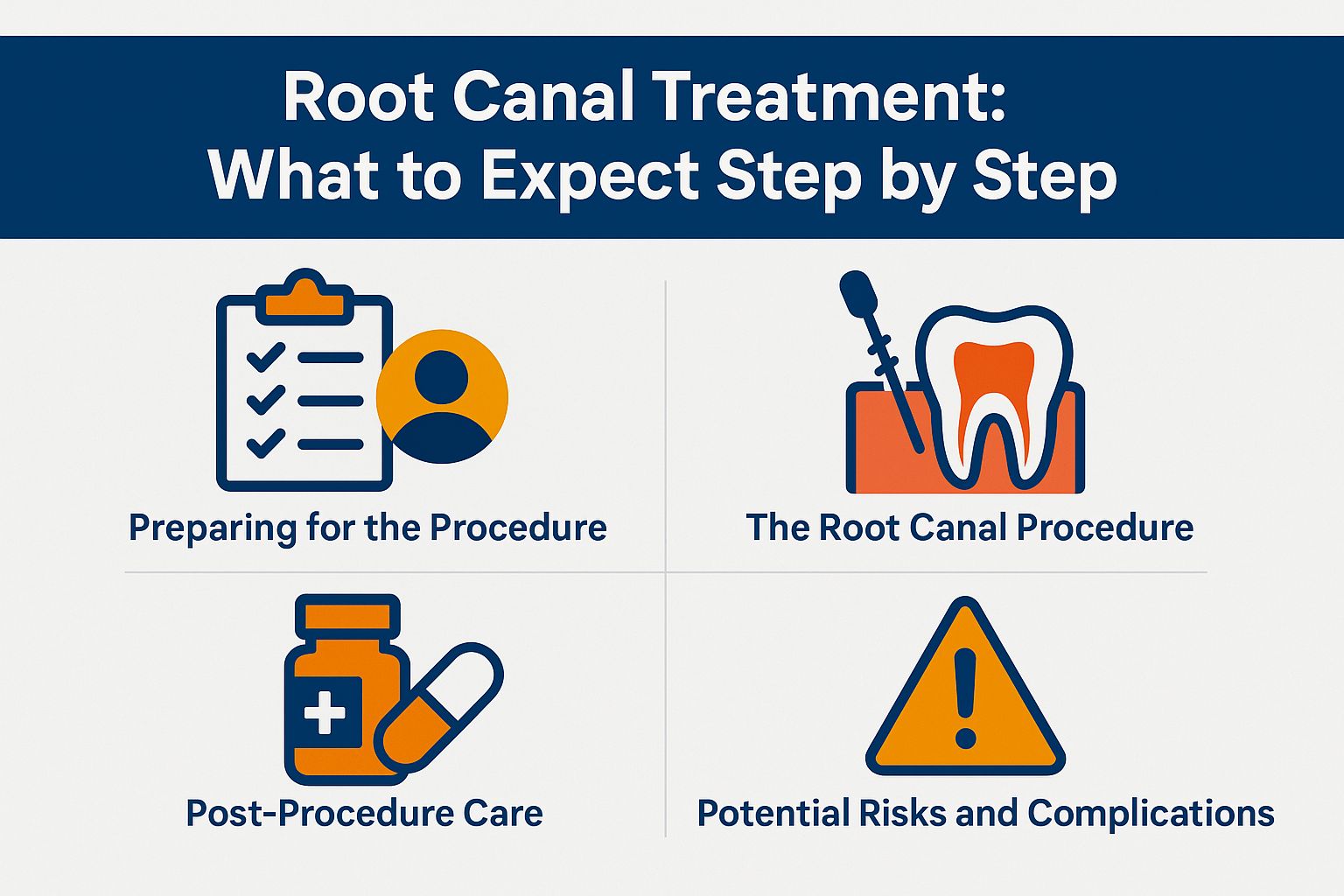
Root canal treatment may feel daunting, but it is essential for saving your tooth. A dental specialist will start the procedure with a local anesthetic to keep you comfortable. This article explains what to expect step by step, helping you approach your root canal with confidence and clarity.
What is a Root Canal?
A root canal is a dental procedure that entails the removal of infected pulp from within the root of a tooth, typically conducted by an endodontist registered with the General Dental Council. The pulp, found in the root canal chamber, holds nerves and blood vessels vital for tooth health. When bacteria infiltrate this area, they can lead to severe infections, resulting in pain and tooth decay.
If left untreated, such infections can cause abscesses. To reduce this risk, practice good oral hygiene, including:
- Regular brushing to prevent tooth decay
- Utilizing antibacterial mouthwash
Additionally, scheduling routine check-ups with a dentist can help identify potential issues early, often preventing the necessity for a root canal or the need for a temporary crown. Using visual aids, like diagrams of tooth anatomy, can improve understanding of these dental concepts.
Common Reasons for Treatment
Most root canal treatments are needed because of infected dental pulp from deep decay, cracks, or trauma. These infections can lead to serious complications if not addressed in a timely manner.
For example, dental abscesses frequently develop, affecting more than 50% of patients with pulpitis.
Sensitivity to temperature can signal issues. Nearly 90% of toothaches link back to pulp problems needing treatment. Patients experiencing persistent pain should seek dental consultation promptly.
Diagnostic tools such as X-rays and the use of a dental dam enable dentists to assess infection severity and decide if a root canal is needed. Early intervention is crucial in preventing further complications and ensuring improved oral health outcomes.
Preparing for the Procedure
Preparing for a root canal involves several key steps, including consultations and diagnostic imaging.

Consultation and Diagnosis
During the consultation, a dental specialist will evaluate the symptoms presented, conduct a clinical examination, and discuss the necessity of a root canal procedure.
Expect questions about your dental history, including previous treatments, pain levels, and swelling. Bring any prior dental records for valuable insights.
The specialist may perform tests, like percussion tests, to check tooth sensitivity. This comprehensive approach aids in accurately determining the underlying cause of the patient’s discomfort and identifying the most suitable course of action, thereby ensuring the provision of appropriate treatment tailored to their specific needs.
X-rays and Treatment Planning
X-rays are essential for diagnosing dental decay and planning root canal treatments. They help specialists see the infected pulp and nearby structures.
Several types of X-rays are employed throughout this process:
- Periapical X-rays focus on the tooth and adjacent bone, highlighting infections or bone loss.
- Bitewing X-rays assist in detecting decay between teeth.
Usually, X-rays are taken during the first visit after the initial consultation. Treatment planning usually occurs within a week, ensuring that the dentist thoroughly understands the condition before proceeding with the root canal procedure.
The Root Canal Procedure
The root canal procedure eliminates infected pulp and cleans the root canal chamber. This process helps preserve the tooth’s integrity.

Anesthesia and Comfort Measures
Before the procedure, the dentist administers local anesthetic for comfort. Additional sedation options are available if needed.
Common local anesthetics include lidocaine and bupivacaine. The dentist chooses based on how long the procedure will take and the patient’s needs.
Common side effects include mild swelling or redness at the injection site. Serious reactions are rare.
Open communication with the patient is essential. Discussing comfort levels and anxieties helps tailor sedation options.
Techniques like deep breathing exercises and a calming environment enhance the experience. Patients feel supported throughout the procedure.
Step-by-Step Process
The root canal procedure has several phases: accessing the root canal chamber, removing the pulp, cleaning and disinfecting the canal, and sealing it.
The procedure begins with the administration of anesthesia to numb the affected tooth, ensuring the comfort of the patient. Subsequently, the dentist creates an access opening in the crown of the tooth to reach the pulp chamber, a process that generally takes approximately 10 to 15 minutes.
Following this initial step, the dentist meticulously removes the infected pulp utilizing specialized instruments, which typically requires 30 to 60 minutes. After the canal has been thoroughly cleaned and disinfected-an essential step to prevent future infections-the dentist seals the canal with a rubber-like material known as gutta-percha.
This entire procedure usually takes one to two appointments. Complexity may require a temporary crown before placing a permanent one.
Post-Procedure Care
Post-procedure care is crucial for healing and preventing complications after root canal treatment. This care includes pain management and scheduling follow-up appointments.

Managing Pain and Discomfort
Managing pain following a root canal procedure typically involves the use of prescribed antibiotics to prevent infection, alongside over-the-counter pain relievers to alleviate discomfort and promote toothache relief.
In addition to medications, applying ice packs to the affected area can reduce swelling. Use ice packs on the affected area for 15 to 20 minutes every hour as needed. Over-the-counter medications like ibuprofen can also be effective; however, it is imperative to monitor dosage carefully. Sensitivity may persist for several days, so it is important to keep track of any unusual pain levels or swelling.
If symptoms worsen or new ones develop, consult your dentist immediately to avoid complications.
Follow-Up Appointments
Follow-up appointments are essential for assessing the success of the root canal and determining the need for a permanent crown. During these visits, the dentist will perform a series of evaluations to ensure that the infection has resolved and that the tooth is healing appropriately. Patients should expect to undergo X-rays to assess bone healing and confirm that no additional treatment is needed.
It is generally advisable to schedule these follow-up appointments at intervals of 1 week, 1 month, and 3 months post-procedure, depending on the complexity of the individual case, to ensure successful tooth restoration. Adhering to this recommended schedule is crucial, as it facilitates timely intervention should any complications arise, thereby ensuring the long-term success of the dental treatment.
Potential Risks and Complications
Root canal treatments are generally safe, but patients should know potential risks and complications.
Understanding these risks helps patients make informed decisions about their dental care and ensures better overall outcomes.

Understanding Possible Side Effects
After treatment, patients may notice side effects like swelling, ongoing pain, or sensitivity to temperature changes.
Swelling often occurs but usually goes away in a few days. Applying ice packs can help reduce this symptom.
If pain lasts longer than a week, it may signal an infection. Patients should consult their dentist for evaluation. Sensitivity to hot or cold may last for several weeks.
Contact your dentist right away if you experience severe discomfort, fever, or unusual discharge. Keep a record of any changes to help discuss them during follow-up appointments for better recovery.
Long-Term Outcomes for Your Oral Health
A successful root canal can lead to a healthy tooth for many years. Research shows a success rate of up to 95%. To keep your treated tooth healthy, follow these tips:
- Brush twice daily
- Floss regularly
- Use antibacterial mouthwash for oral health
Schedule dental check-ups every six months to check your tooth and surrounding areas. Avoid hard foods that could harm your tooth or its restoration.
Following these practices can greatly improve your dental health and extend the life of your teeth, especially those treated with root canal therapy involving pulp removal and the use of a Dental dam, Gutta-percha, and sometimes antibiotics prescribed for Tooth abscess or Pain relief.



